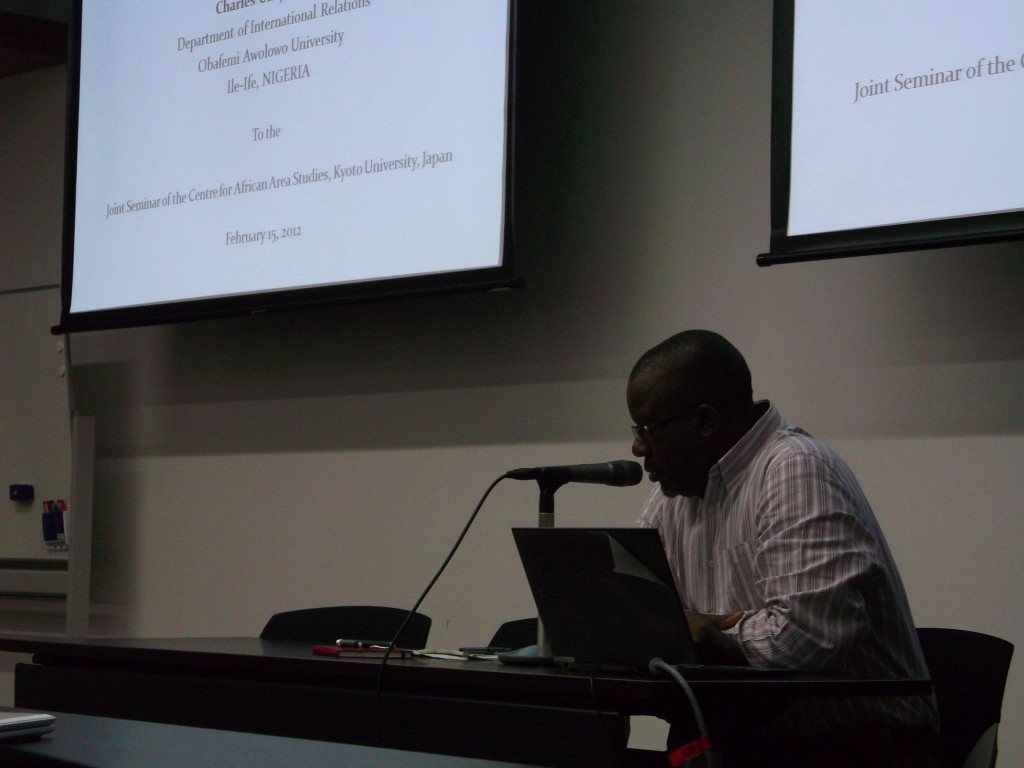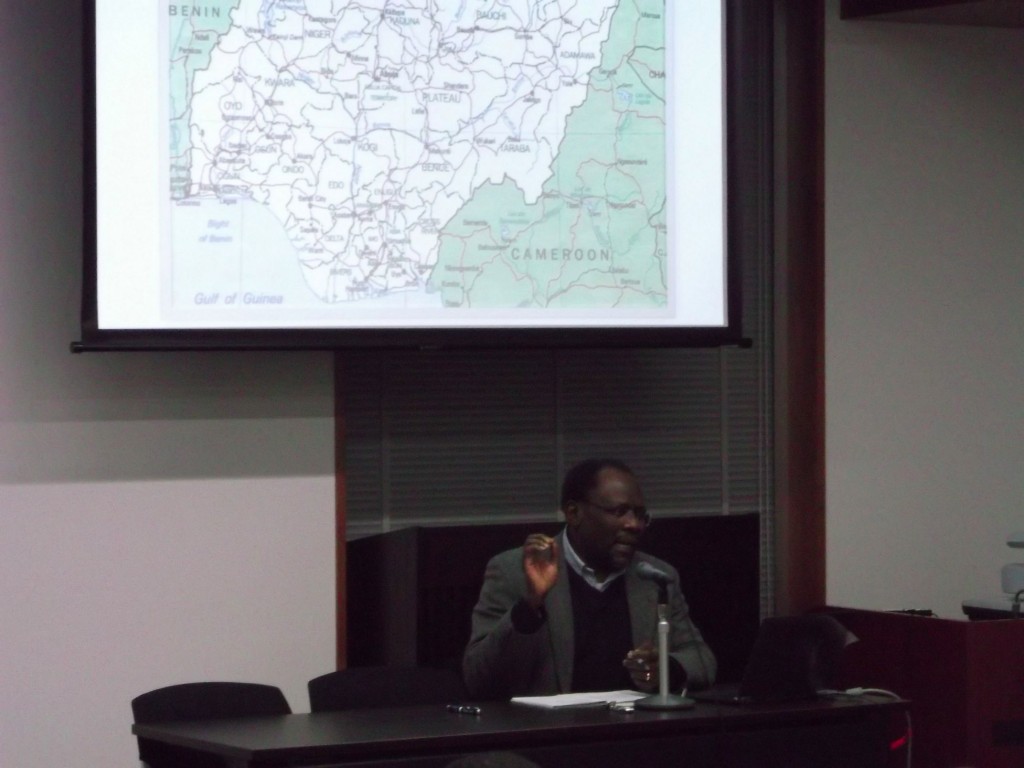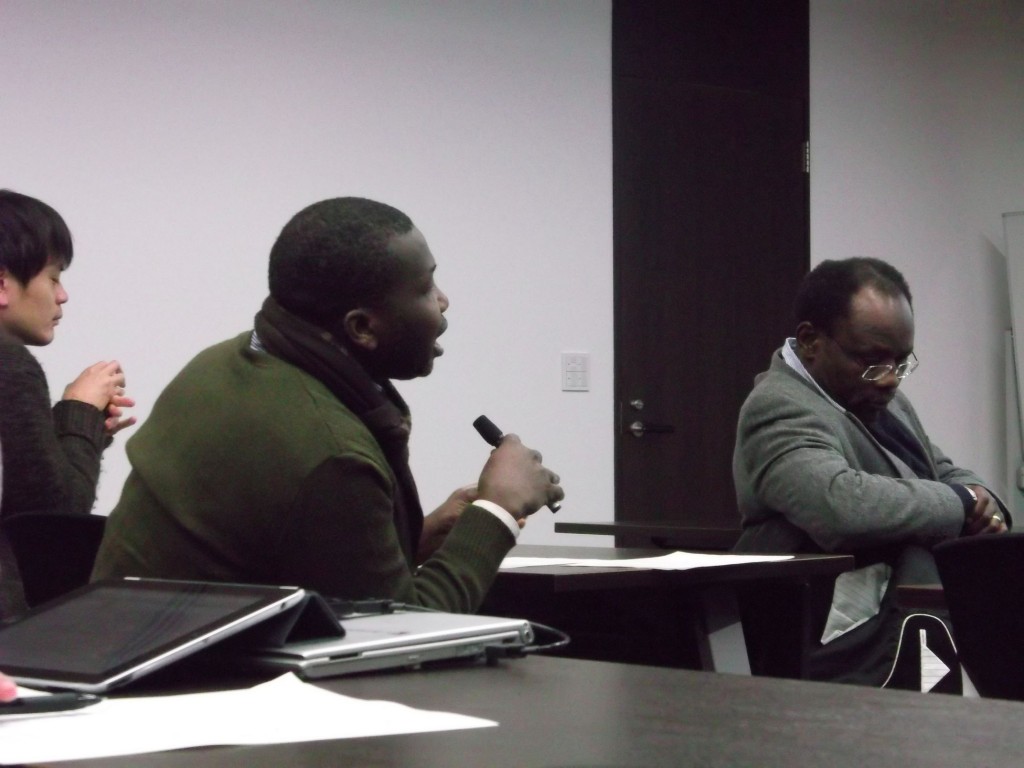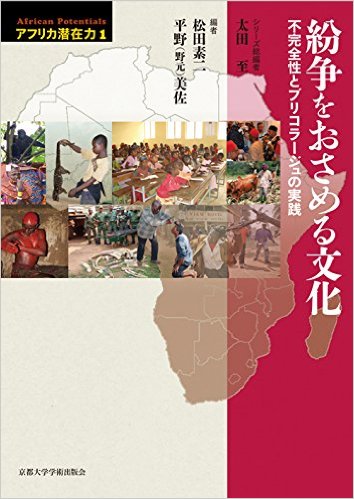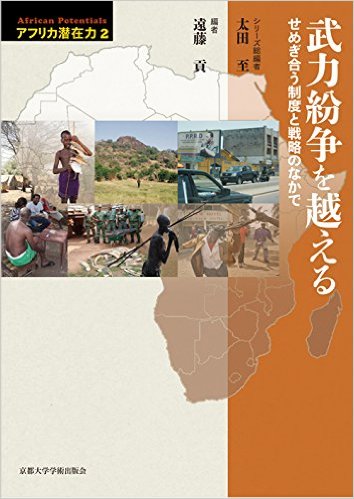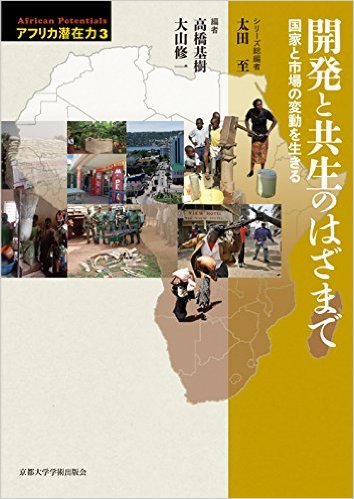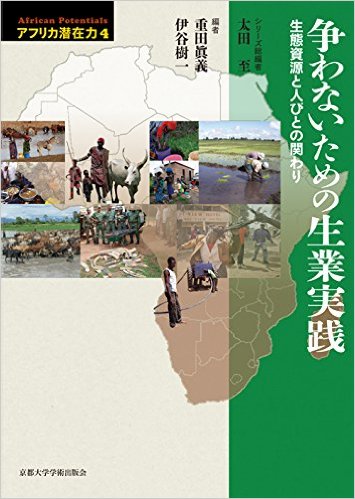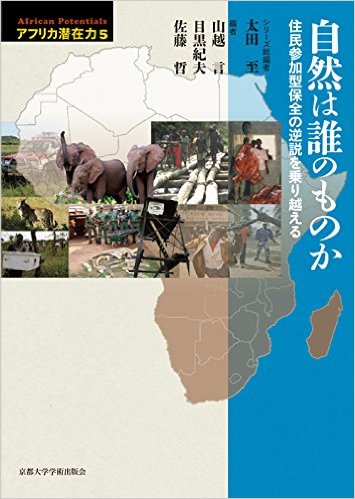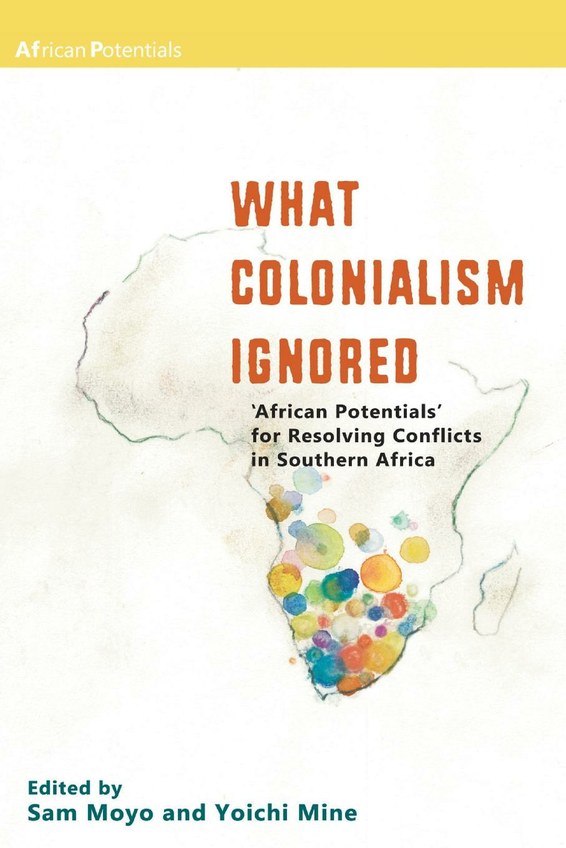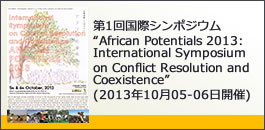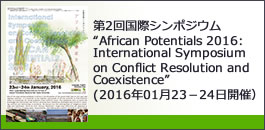[西アフリカ・クラスター第10回研究会/第21回公開ワークショップ/政治・国際関係ユニット第11回研究会]「Informalization and Its Discontents & Violent Islamic Radicalization」(第29回Kyoto University African Studies Seminar (KUASS)との共催、2014年11月21日開催)
日 時:2014年11月21日(金)14:00〜17:00
場 所:稲盛財団記念館中会議室
プログラム
Prof Abdul Raufu Mustapha (Oxford University)
Violent Islamic Radicalization:Northern Nigeria in the light of the experience of southern Niger Republic
Kate Meagher (London School of Economics)
Informalization and Its Discontents: The Informal Economy and Islamic Radicalization in Northern Nigeria
Abstract
Mustapha, A. Raufu
Violent Islamic Radicalization: Northern Nigeria in the light of the experience of southern Niger Republic
At first glance, northern Nigeria and southern Niger Republic share a number of important religious, economic, and social characteristics.
- Both belong to the sahelian cultural belt just south of the Sahara, running from Senegal to Somalia; a zone in which Islam has exercised significant influence for over a thousand years.
- The two regions are also united by the prevalence the Hausa language.
- Both are regrettably regions of high levels of poverty and depressed socio-economic indicators.
- Finally, they both share a complex admixture of sectarian communities of Sufi Brotherhoods and reformist strands of Islam.
Since the early 19th century, religious and political ideas, religious groups, economic actors, and political forces have moved back and forth across the boundary between both regions. In the process, events in one region have tended to have ramifications for developments in the other. For instance, the Sokoto jihad of 1804 spread Qadiriyya Brotherhood influence to the territories that are now in Niger Republic and many ‘of the wealthiest merchants of Niger belong to this order, whose members are referred to locally as ‘yan sadalu’. Similarly, the Tijaniyya-Ibrahimiyya Brotherhood was spread from Kano to Niger in the 1950s and its members are known locally as the ‘yan kabalu’. Significantly, the Qadiriyya-Tijaniyya conflicts which racked Nigeria in the 1950s and 1960s also took place in Niger. In the same vein, the reformist Salafist Nigerian sect, Izala, also made an appearance in Niger Republic in the 1980s, having been formed in Nigeria. As in Nigeria, the appearance of this reformist Salafist sect generated high levels of religious discord with the established Sufis in Niger. And as happened in Nigeria, Izala also broke into two main factions.
Though the flow and ebb of ideas and people go in both directions, there is the recognition of Nigeria’s formidable cultural, religious, and economic influence on Niger. This is captured in the Nigerien saying: ‘When Nigeria has a cold, Niger coughs’.
Since 2009, northern Nigeria has been battling a stubborn Islamist insurgency spear-headed by the Boko Haram. Analysts have been speculating on the possible consequence of this insurgency for Niger Republic, given the shared characteristics between both regions. Why has there not been the development of a similar insurgency in Niger? This lecture reflects on this question. The lecture compares the drivers of possible radicalization in both regions, looking specifically at: (a) the variable cultural geographies of within and between the two region; (b) impact of historical forces; (c) the importance of economic processes; (d) the political and administrative dynamics in both regions; and (e) religious factors, especially the place of Christianity in both regions and the prevalence of some religious ideas such as secularism. Through such a comparison, it should become clearer why, despite their seeming similarities, violent Islamist radicalization remains dormant in southern Niger but active in northern Nigeria.
Meagher, K.M.B. Kelly (London School of Economics)
Informalization and Its Discontents: The Informal Economy and Islamic Radicalization in Northern Nigeria
This seminar explores the dark side of inclusive markets in the context of northern Nigeria. It examines how strategies of economic inclusion generate new dynamics of exclusion through processes of selective inclusion and marginalization. Despite the celebrated resurgence of the Nigerian economy, the majority of the population has remained trapped in the realities of jobless growth, rising poverty and expanding economic informality. The interface of historical disadvantage, economic reforms, and the dynamics of the global economy have exacerbated problems of regional inequality within Nigeria, concentrating the benefits of inclusive markets in the south and the negative side-effects in the northern region of the country, fostering escalating poverty, disaffection and Islamic extremism.
Drawing on fieldwork conducted in the northern Nigerian cities of Kano and Kaduna in 2014, I will explore the nature and limitations of inclusive economies within the context of northern Nigeria’s vibrant informal economy. I will focus on how inclusive economies have exacerbated economic stress within northern Nigeria, and generated new and increasingly problematic processes of exclusion. Based on interviews with operators and associational leaders in a selection of eight common informal production and service activities, I show how mounting economic pressures are restructuring patterns of ownership, social identity, educational attainment and religious affiliation within the informal economy. Indigenous institutions and networks of religious tolerance and economic interdependence are being eroded by new patterns of competition over access to informal jobs based on education and identity. Popular disaffection is heightened by human rights abuses by security forces and graduate employment programmes, which further marginalize poor and less-educated informal actors, exacerbating economic stress and resentment against the state, and creating a tinderbox for violence and Islamic extremism.
[西アフリカ・クラスター第9回研究会/政治・国際関係ユニット第10回研究会]「Islamic Radicalization in Nigeria」(2014年11月19日開催)
日 時:2014年11月19日(水)16:00〜18:00
場所:東京大学駒場キャンパス 18号館4階コラボレーションルーム1
プログラム
Prof Abdul Raufu Mustapha (Oxford University)
Violent Islamic Radicalization:Northern Nigeria in the light of the experience of southern Niger Republic
Informalization and Its Discontents: The Informal Economy and Islamic Radicalization in Northern Nigeria
Abstract
Mustapha, A. Raufu
Violent Islamic Radicalization: Northern Nigeria in the light of the experience of southern Niger Republic
At first glance, northern Nigeria and southern Niger Republic share a number of important religious, economic, and social characteristics.
- Both belong to the sahelian cultural belt just south of the Sahara, running from Senegal to Somalia; a zone in which Islam has exercised significant influence for over a thousand years.
- The two regions are also united by the prevalence the Hausa language.
- Both are regrettably regions of high levels of poverty and depressed socio-economic indicators.
- Finally, they both share a complex admixture of sectarian communities of Sufi Brotherhoods and reformist strands of Islam.
Since the early 19th century, religious and political ideas, religious groups, economic actors, and political forces have moved back and forth across the boundary between both regions. In the process, events in one region have tended to have ramifications for developments in the other. For instance, the Sokoto jihad of 1804 spread Qadiriyya Brotherhood influence to the territories that are now in Niger Republic and many ‘of the wealthiest merchants of Niger belong to this order, whose members are referred to locally as ‘yan sadalu’. Similarly, the Tijaniyya-Ibrahimiyya Brotherhood was spread from Kano to Niger in the 1950s and its members are known locally as the ‘yan kabalu’. Significantly, the Qadiriyya-Tijaniyya conflicts which racked Nigeria in the 1950s and 1960s also took place in Niger. In the same vein, the reformist Salafist Nigerian sect, Izala, also made an appearance in Niger Republic in the 1980s, having been formed in Nigeria. As in Nigeria, the appearance of this reformist Salafist sect generated high levels of religious discord with the established Sufis in Niger. And as happened in Nigeria, Izala also broke into two main factions.
Though the flow and ebb of ideas and people go in both directions, there is the recognition of Nigeria’s formidable cultural, religious, and economic influence on Niger. This is captured in the Nigerien saying: ‘When Nigeria has a cold, Niger coughs’.
Since 2009, northern Nigeria has been battling a stubborn Islamist insurgency spear-headed by the Boko Haram. Analysts have been speculating on the possible consequence of this insurgency for Niger Republic, given the shared characteristics between both regions. Why has there not been the development of a similar insurgency in Niger? This lecture reflects on this question. The lecture compares the drivers of possible radicalization in both regions, looking specifically at: (a) the variable cultural geographies of within and between the two region; (b) impact of historical forces; (c) the importance of economic processes; (d) the political and administrative dynamics in both regions; and (e) religious factors, especially the place of Christianity in both regions and the prevalence of some religious ideas such as secularism. Through such a comparison, it should become clearer why, despite their seeming similarities, violent Islamist radicalization remains dormant in southern Niger but active in northern Nigeria.
Meagher, K.M.B. Kelly (London School of Economics)
Informalization and Its Discontents: The Informal Economy and Islamic Radicalization in Northern Nigeria
This seminar explores the dark side of inclusive markets in the context of northern Nigeria. It examines how strategies of economic inclusion generate new dynamics of exclusion through processes of selective inclusion and marginalization. Despite the celebrated resurgence of the Nigerian economy, the majority of the population has remained trapped in the realities of jobless growth, rising poverty and expanding economic informality. The interface of historical disadvantage, economic reforms, and the dynamics of the global economy have exacerbated problems of regional inequality within Nigeria, concentrating the benefits of inclusive markets in the south and the negative side-effects in the northern region of the country, fostering escalating poverty, disaffection and Islamic extremism.
Drawing on fieldwork conducted in the northern Nigerian cities of Kano and Kaduna in 2014, I will explore the nature and limitations of inclusive economies within the context of northern Nigeria’s vibrant informal economy. I will focus on how inclusive economies have exacerbated economic stress within northern Nigeria, and generated new and increasingly problematic processes of exclusion. Based on interviews with operators and associational leaders in a selection of eight common informal production and service activities, I show how mounting economic pressures are restructuring patterns of ownership, social identity, educational attainment and religious affiliation within the informal economy. Indigenous institutions and networks of religious tolerance and economic interdependence are being eroded by new patterns of competition over access to informal jobs based on education and identity. Popular disaffection is heightened by human rights abuses by security forces and graduate employment programmes, which further marginalize poor and less-educated informal actors, exacerbating economic stress and resentment against the state, and creating a tinderbox for violence and Islamic extremism.
[西アフリカ・クラスター第8回研究会]「ナイジェリアのポテンシャルをめぐって」(2014年11月7日開催)
日 時:2014年11月7日(金)
場 所:稲盛記念館3階小会議室II
島田周平(東京外国語大学)
「ナイジェリアのポテンシャルをめぐって」
島田周平氏は「潜在力」を考える際に、「潜在力」が及ぶ社会的・空間的・時間的範囲と、「潜在力」はプラスに働く場合とマイナスに働く場合がある点を常に意識しなければならないと述べ、「潜在力」がナイジェリアの地域紛争においてどのように機能しているのかを考察した。まず、ナイジェリアの地域紛争の背景を説明したのちに、ナイジェリアの地域紛争の特徴として、経済権益をめぐる争い、武力を背景とした実利主義の存在を説明した。また、紛争のさなかで、自警団、政治家の私兵、企業保安員、日雇い傭兵などの、あらゆるタイプの武装集団が出現しており、それらの武装集団は流動性の高い人々によって構成されていたことを説明した。そして、実利主義的な武力紛争が起こる背景として、ハウス制度がマイナスの「潜在力」として働いている点を示した。次に、ボコハラム運動が、1980年代頃から既に生じていた問題であることを示し、元々北部ナイジェリアのイスラーム社会で生じた活動が、次第に北部ナイジェリア全域、ナイジェリア全土、国際的イスラーム社会、国際社会へとスケールを拡大してゆき、もはやローカルな潜在力が働く余地のない範囲にまで及んでいると考察した。最後に、靴商人によって結成されたBakassi Boysの事例をとりあげ、政治に取り込まれることによって、市民組織が保持する機能が働かなくなることを示し、「潜在力」が機能する社会的スケールの限界を指摘した。(伊藤義将)
[西アフリカ・クラスター第7回研究会/第18回公開ワークショップ]Murray Last「The Dilemma in Being an Islamic Radical in Northern Nigeria: Whether Non-violent or Violent」(第24回Kyoto University African Studies Seminar (KUASS)との共催、2014年05月20日開催)
日 時:2014年5月20日(火) 15:00~17:00
場 所:京都大学稲盛財団記念館3階318号室
プログラム
演題:The Dilemma in Being an Islamic Radical in Northern Nigeria: Whether Non-violent or Violent
演者:Prof. Murray Last (ロンドン大学名誉教授)
要 旨
[西アフリカ・クラスター第6回研究会]宮田寛章「子どもの妖術師問題」(2014年01月25日開催)
日時:2014年1月25日(土)10:30~12:00
場所:稲盛財団記念館3階小会議室1
プログラム
「子どもの妖術師問題」
宮田寛章(京都大学大学院アジア・アフリカ地域研究研究科)
報告
アフリカ各地における妖術告発の現状について報告したうえで、子供の妖術師に関する先行研究を紹介した。子供のもつ自己顕示癖と物質的な動機から心理学的に分析した研究、妖術告発を長老の権威の低下を分析した研究がある。妖術の脅威に適切に対処しなければならないが、旧来の方法では対処できなくなっている。近年の妖術告発や妖術師撲滅運動は暴力をともなうし烈なものになっている。ナイジェリア南部のナイジャーデルタに居住するエフィック・イビビオ社会では、妖術(Ifot)は、死を含むあらゆる害悪をもたらす不可思議な超自然的な力であり、黒妖術と無害な白妖術がある。妖術師は生得的なもので、霊的な力をもつ。妖術への対処としては、伝統医、スピリチュアリスト、ペンテコスタル教会の牧師に相談し、問題が妖術である場合には、妖術師を断定してもらう。その人物への自白、妖術を解いてもらうよう頼み、特殊な薬を飲ませて、妖術師であるか判断する。その判断によって、妖術師とされた人物が殺害されることもある。子供の妖術師問題は2000年前後から増加しはじめ、告発される対象が老人から子供へと変化した。その背景には、妖術告発をするペンテコスタル教会の牧師やスピチュアリストといった宗教的職能者の存在がある。子供の妖術告発は、子供の両親や近親者によってなされるという特徴があり、子供の再統合に対する取り組みの現状と課題という興味深い報告がなされた。
(大山修一)
[西アフリカ・クラスター第5回研究会]「誰が道路を止めたのか:カメルーン東南部、バクエレの妖術と開発」(2013年10月26日開催)
日時:2013年10月26日(土)
場所:東京外国語大学本郷サテライト3階セミナー室
プログラム
山口亮太(京都大学大学院アジア・アフリカ地域研究研究科)
「誰が道路を止めたのか:カメルーン東南部、バクエレの妖術と開発」
報告
山口氏は、カメルーン東南部の民族バクエレが暮らすある村で起こった道路建設をめぐる「紛争」について論じた。この村周辺の人々は、19世紀末以降、ドイツ人の進出やフランスによる強制労働、他民族の移動などに翻弄されながら、現地域に定着した。この地域には1970年代から伐採会社が進出し、道路が建設され、村々は川沿いから道路沿いに移動した。同時に、異邦人や現金が流入するなど社会変動にも見舞われた。
この地域の村々を通っていた道路は、1980年代に伐採会社が撤退すると荒廃し、通行が困難な状況が続いていた。2010年には、村々にとって念願であった道路改修工事が開始されたが、ある村で重機の故障により改修が止まり、奥の村まで道路が届かなくなった。その後、道路が届かなかった村々で、工事停止の原因がある人物のエリエーブ(妖術)によるものだという噂が広まった。それを解決するため、村の代表があつまって会議が行われたが、解決には至らなかった。
山口氏は、この「紛争」で焦点となったエリエーブについて分析し、エリエーブは肯定的にも否定的にも作用する両義性をもつこと、持ち主に働きかける内なる強制力、あるいは逆に持ち主がコントロールできる道具性という両面で語られていることを論じ、モダニティとローカルな出来事の接続による新しいエリエーブの可能性を示唆した。
発表の後の質疑では、エリエーブの性質についてや、他地域の妖術との比較などが議論された(平野美佐)。
[西アフリカ・クラスター第4回研究会 & 政治・国際関係ユニット第6回研究会]Kate Meagher「The Strength of Weak States?: Hybrid Governance and Non-State Security Forces in Nigeria and the Congo」(2012年11月9日開催)
日 時:2012年11月9日(金)18:00~19:30
場 所:東京大学駒場キャンパス18号館4階コラボレーションルーム3
プログラム
18:00~19:30
Kate Meagher (London School of Economics and Political Science)
ケート・ミーガー(ロンドン政治経済学院)
“The Strength of Weak States?: Hybrid Governance and Non-State Security Forces in Nigeria and the Congo”
「弱い国家の強さ―ナイジェリアとコンゴにおけるハイブリッドなガバナンスと非国家保安部隊」
要旨
This lecture will look at whether non-state security forces (vigilantes, militias, etc.) can provide a second-best source of security in fragile regions. It starts with a critique of new ‘hybrid governance’ approaches to state-building, which encourage the integration of informal security arrangements into state structures. This sets the scene for a comparative analysis of the Bakassi Boys of Nigeria and the RCD-ML militia in the Eastern DRC, which challenges the notion that informal security arrangements necessarily enjoy local legitimacy, and raises questions about their potential for improving the governance context even if they start out as locally legitimate forces.
[西アフリカ・クラスター第3回研究会]大山修一「ニジェールの人口増加問題と『現金獲得の糸口』―農耕民社会からみた牧畜民とのコンフリクトの背景―」(2012年07月14日開催)
日 時:2012年7月14日(土)15:00~17:00
場 所:京都大学稲盛財団記念館3階 301室
プログラム
「ニジェールの人口増加問題と『現金獲得の糸口』―農耕民社会からみた牧畜民とのコンフリクトの背景―」
大山修一(京都大学)
報告
ニジェールの人口増加率は3.5%と非常に高く、合計特殊出生数は7.1、20年で人口が2倍になる驚異的なペースである。どうして人口が急増するのか、ハウサの農村社会の論理を”harkuki(動き)”という概念で説明したうえで、農耕、牧畜、副職業、出稼ぎといった積多角的な経済活動に積極的に従事する人々の姿を示した。農村では、外部社会からの現金収入の多寡に応じて経済格差が大きく、所有する畑の面積、収穫量、家畜飼養のサイズに大きな差異が存在する。急増する人口によって、相続で受け取る畑の面積も縮小する傾向が強い。農耕や牧畜といった村内活動では自給ができない世帯も増加している。そうした世帯では、食料不足が慢性化しており、雨季における牧畜民による作物の食害で賠償金を得ようする人々も出現している。農耕民は、収穫したトウジンビエを故意に畑のなかに放置しておき、家畜がトウジンビエを食べたことをもって、牧畜民から賠償金を得ようとするのである。ハウサ社会では、このようなことを、「現金獲得の糸口(Bidan kudi)」と呼ぶこともある。サヘル地域では、雨季における農耕民と牧畜民の衝突が頻発し、その理由として稀少な土地資源をめぐってコンフリクトが起きると説明される。しかし、実際には、土地をめぐって争うのではなく、作物の食害をめぐる事実の認定をめぐって、意見が衝突し、その交渉がまとまらないときに、武力衝突に発展することが多い。食害認定の交渉では、当事者だけではなく、農耕民、牧畜民ともに代理人をたて、その代理人どうしは顔見知りであることが重要である。サヘル社会における、農耕民と牧畜社会のあいだで起きるコンフリクト、および、その修復に対する人々の取り組みを議論した。(大山修一)
[西アフリカ・クラスター第2回研究会/第6回公開ワークショップ]佐藤章「コードジボワールに見る紛争解決のジレンマ」(第186回アフリカ地域研究会との共催、2012年02月16日開催)
日 時:2012年2月16日 (木)15:00〜17:00
場 所:京都大学稲盛財団記念館3階中会議室
プログラム
「コードジボワールに見る紛争解決のジレンマ」
佐藤 章(アジア経済研究所・副主任研究員)
要 旨
アフリカの紛争では,国連や先進国が解決に向けて積極的な取り組みを行なうが,その努力が速やかに実を結ぶことはまれである.治安回復に大きな役割を果たす平和維持部隊は,しばしば逆に軍事的状況を刺激することがあるし,無事に選挙にこぎ着けたとしても,それだけで永続的な平和が約束されるわけではない.和平プロセスの締めくくりとなる2010年選挙を契機として,内戦が再燃する事態に至ったコートジボワールの経験は,このジレンマの典型を示している.コートジボワールの和平プロセスを振り返りながら,なぜこのような事態に至ったのかを考察し,国際的主体による外部介入が直面するジレンマとその根底にある原因を検討することで,アフリカの紛争解決の難しさについて考えてみたい.
[西アフリカ・クラスター第1回研究会/第5回公開ワークショップ]「ナイジェリアにおける地域紛争の最新報告~資源開発地域とイスラーム地域での地域紛争」 (第5回Kyoto University African Studies Seminar (KUASS)との共催、2012年02月15日開催)
日 時:2012年2月15日(水)15:00 ~ 17:00
場 所:京都大学稲盛財団記念館3階中会議室 (京都市左京区吉田下阿達町46)
共 催: 科学研究費補助金基盤研究(B) 「アフリカの地域紛争にみられる新兆候に関する研究:ナイジェリアの事例を中心に」
科学研究費補助金基盤研究(S) 「アフリカの潜在力を活用した紛争解決と共生の実現に関する総合的地域研究」
プログラム
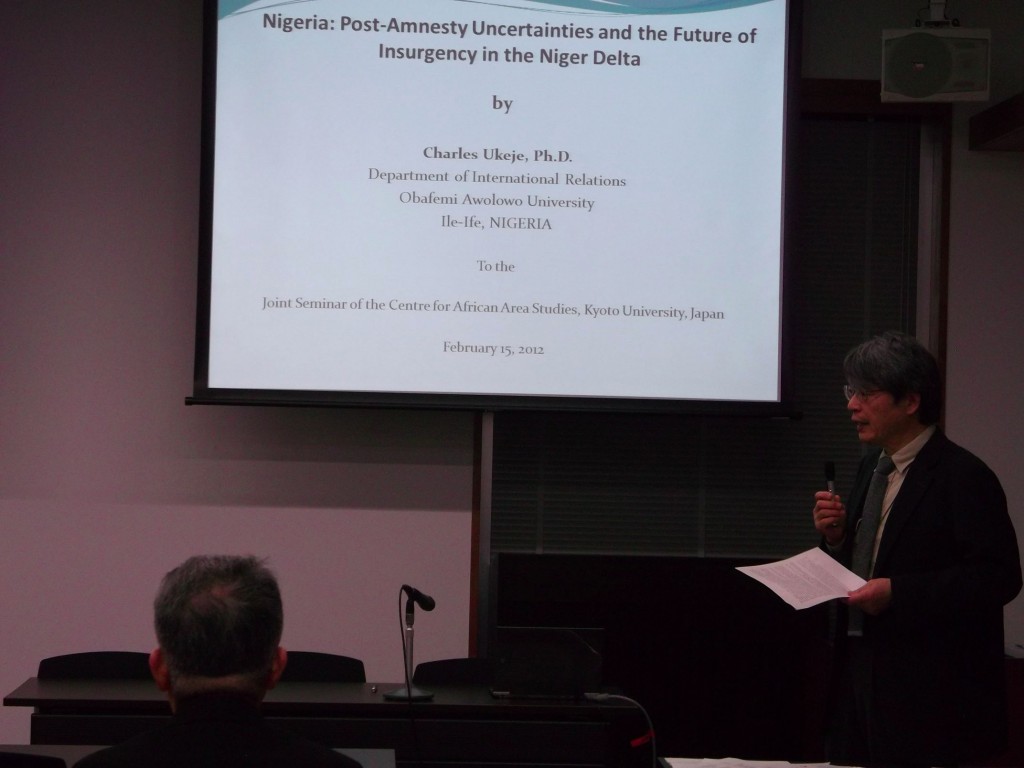
「Nigeria: The Post-Amnesty Blues and the Future of Insurgency in the Niger Delta」
・Dr. M. Raufu(オックスフォード大学)
「Boko Haram: The long road to Islamic Terroism」
アブストラクト(PDF File)>>
報告
